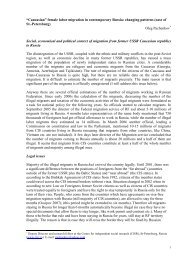THORIUM AS AN ENERGY SOURCE - Opportunities for Norway ...
THORIUM AS AN ENERGY SOURCE - Opportunities for Norway ...
THORIUM AS AN ENERGY SOURCE - Opportunities for Norway ...
You also want an ePaper? Increase the reach of your titles
YUMPU automatically turns print PDFs into web optimized ePapers that Google loves.
Radiation Protection of Man and the Environment<br />
years, and, perhaps more importantly, has a smaller volume compared with the use of enriched<br />
uranium. The closed Th-cycle offers better per<strong>for</strong>mance with respect to long-lived waste<br />
radiotoxicity compared with U/Pu fuels, in particular if fast reactors are used.<br />
Thorium based fuel cycles (Th/U) produce much less plutonium and associated minor actinides<br />
than uranium based fuels. The key dose contributions of concern are the generation of Pa-231,<br />
Th-229 and U-233 and their daughters. The radioactivity of the waste from a thorium cycle<br />
appears, however, significantly less than <strong>for</strong> the standard U/Pu cycle, in the same conditions. This<br />
is an advantage of thorium based fuels and has been confirmed in several studies, recently in the<br />
EU supported study “Thorium as a waste management option” [138].<br />
7.4 Safety and Accidents<br />
Following the installation and operation of the first nuclear reactor in USA, there has been a<br />
series of events and some major accidents (International Nuclear Event Scale (INES) 6 or 7)<br />
associated with uranium fuelled reactors. Furthermore, a number of criticality accidents have<br />
occurred off-line, in association with fuel production or spent fuel handling. IAEA has registered<br />
all events associated with nuclear reactor accidents, while UNSCEAR has also summarized<br />
in<strong>for</strong>mation on criticality accidents and the number of fatalities and injuries associated with such<br />
accidents [149].<br />
Most of the criticality accidents occurred during the early years from 1940 to the 1960s. The<br />
latest accident occurred in Japan in the 1990s due to human failure. Similarly, most of the<br />
accidents associated with nuclear reactors occurred during the 1950s and 1960s in prototype<br />
reactors, military reactors, Generation I reactors and early Generation II reactors. Among all<br />
these cases, three serious reactor accidents have occurred. In 1957 a graphite fire in an early<br />
designed air-cooled graphite moderated metal uranium reactor at Windscale, UK. Two such<br />
reactors operated from 1951 to 1957, when both were shut down due to the fire. A serious<br />
accident occurred in 1979 at Harrisburg in one of the Three Mile Island reactors due to human<br />
failure. The reactor was a pressurized Generation II reactor. Due to the safety precautions such<br />
as containment, however, only traces of gases, mostly noble gases, were released to the<br />
environment. In 1986, the worst ever accident in a nuclear reactor occurred in Chernobyl (a<br />
graphite moderated reactor) due to human failure and the construction features of the reactor<br />
(positive void coefficient). The accident resulted in the release of tonnes of uranium fuel and<br />
fission products since this reactor type does not have a containment building. A few such reactors<br />
are still operating in Russia. Based on the report from the Chernobyl Forum (IAEA, WHO, FAO),<br />
summing up the consequences 20 years after the Chernobyl accident [150], 14·10 18 Bq was<br />
released, 340 000 people were evacuated, in total 62 people died as a result of the accident, either<br />
due to the fire or due to radiation induced diseases such as thyroid cancer (about 6000 children<br />
were sick, 15 died, and the remainder were cured), and the social and economic consequences<br />
were large. Radiation effects (dead <strong>for</strong>est) were observed in the environment during the first year<br />
following the accident. According to the Forum scientists, the biodiversity 20 years after the<br />
accident is richer than be<strong>for</strong>e the accident. They attribute this circumstance to the fact that 340<br />
000 people were evacuated so that the environment is no longer affected by human activities.<br />
Although the long-term consequences still are to be seen, the health and environmental<br />
consequences directly linked to radiation exposures are so far significantly less severe than<br />
claimed by many organisations.<br />
Following these accidents, significant improvement in reactor safety and handling of nuclear<br />
materials have been made, both technically and culturally, in particular <strong>for</strong> the Generation III<br />
reactors and in the planning of Generation IV reactors. The largest nuclear reactor in the world,<br />
83

















